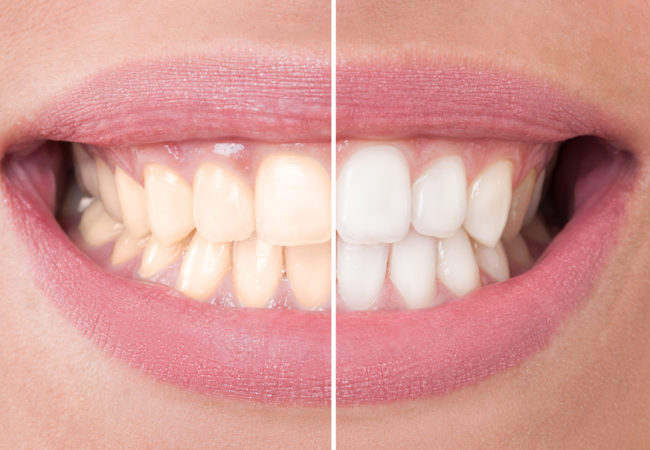Want that smile white? Ask your dentist first
Before and after bleaching
April 3, 2019
What’s one of the first things you notice when you meet someone for the first time? A majority of people notice their smile and teeth; whether color, shape, or the general health and cleanliness. Most people have strong feelings about their smile and always wish to get the perfect smile to help boost self-esteem.
Unfortunately, a lot of people aspire to improve the aesthetics, but usually not the health of their teeth prior to whitening. Doing so has its risks, especially without proper diagnoses and discussion with the doctor prior. With the advancements in dental technology, there are many products on the market now claiming that they’re the best product out there. Often, they’ll brag about the cost, the effectiveness, lack of sensitivity while using the product, as well as the “everyone’s doing it” mindset to push onto patients. Here is some advice about various methods of whitening from doctors at Grand Dental Lake Zurich.
The most common active ingredient in bleaching products are either hydrogen peroxide or carbamide peroxide (which converts to hydrogen peroxide in a chemical reaction). Various methods of whitening offer different percentages of concentration, which is why some may seem more effective than others. Although bleach is bleach, companies use additives in the products to try helping manage sensitivity and delivery of bleach into the tooth.
One of the most efficient time-wise, but high-priced is in-office treatment. It can be a beautiful thing, but there are a lot of different factors to consider when scheduling your appointment. Several types of in-office whitening are LED light, in-office trays, and take-home trays with a clinical solution. Another thing to think about is the concentration of solution you’ll be using, which is why consulting with your dentist is always a smart idea before proceeding with any whitening in general.
LED light therapy is a newer fad and while it may seem appealing to many, the doctors I interviewed shared a consensus. “The activation of in-office bleaching gel with light does not seem to improve color, change or affect tooth sensitivity, regardless of the hydrogen peroxide concentration” according to the National Center of Biotechnology Information regarding a study they published in March 2018. Dr. Marcus Montoya brings up a commonly discussed point on this method stating that “this process could be argued saying that the light acts as a catalyst to heat up the gel, but truthfully teeth whiten without light.” Overall, all three doctors, from Lake Zurich, agreed that LED light therapy has no factual benefits and that it’s nothing more than a marketing scheme.
In-office whitening and take-home trays will yield the best results, with custom fitted trays and clinical strength solution. Companies such as Opalescence have grown due to the effectiveness of their products with five different amounts of concentrations of hydrogen peroxide. Most of these concentration levels will be higher than what you’d be able to buy over the counter. Performing this therapy in office is beneficial to those with a busy schedule as a higher concentration of bleach is used (45%, OTC is 3-10%), allowing for three 15-minute sessions to be completed on the same day. The risk of using such a high concentration is…. you guessed it — increased sensitivity as well as gum inflammation. If you work with your doctor and follow their advice, you can get a whiter smile without damaging your teeth as much as if you were to go renegade and take it into your own hands.
The most common option people tend to go for are the over the counter (OTC) products such as Crest 3D White, as well as all the other competitor products out there. As previously mentioned, these strips carry a lower risk of sensitivity due to the low bleach content. Naturally, these are found to be a convenient product as you can grab it at about any store these days. Both Dr. Montoya and Dr. Taina Yanez agree that while bleach in the product will still yield results, it won’t be as effective as in-office. Whitening strips could be challenged as saliva can get under the strips to wash out the solution, and poorly made trays could cause poor whitening if there isn’t a solid seal against the gumline. However, Dr. Montoya recommends Kor whitening trays as they have the best seal.
The toothpastes unfortunately aren’t a much better solution, as they are found to be extremely abrasive to teeth. The challenge with toothpastes is that the bleach is supposed to sit on teeth for 15 minutes to take effect. While we find ourselves brushing for 2-3 minutes, the saliva begins washing the paste off our teeth as well causing it to be less beneficial. The only product that had been mentioned multiple times (that wasn’t a clinical solution) was Sensodyne Tru White. It claims to be less abrasive than other toothpastes and manages to whiten while protecting against sensitivity.
This last option has become increasingly popular lately, and it hurts to see people using these products. Many dentists are shocked about the use of charcoal toothpaste. Dr. Yanez puts it best when she said: “Charcoal? Whose idea was that? I wouldn’t even try it on a test rat. People will start to wonder why they go from thinking they see whitening results to yellow… that’s because there’s no enamel left!”
These products are not approved by the American Dental Association as studies have yielded little evidence that they are safe. They advise patients to be very cautious when using these products with their unproven claims of efficiency and safety. No matter what any website or ad claims, this product is not one that is safe for your teeth and will be a costly mistake down the road. I’ve also seen many false claims that these products will whiten crowns, veneers, dentures, fillings and any other synthetic teeth, which is very deceiving. Remember, these pieces of dental work cannot have color adjusted as they are porcelain and the color is set for the duration of its life.
Honestly, in the end it really comes down to what matters to you. To understand which method will be the most effective for you, go to your dentist (because let’s be honest… you’re probably overdue). Consulting in-office will give you the opportunity to discuss the reality of how white your teeth will lighten, risks and concerns, how to work against the bleach content causing sensitivity, and what option is best suited for you.
Happy (and safe) whitening!
–











